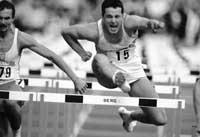Doping not favoring
2000/10/03 Roa Zubia, Guillermo - Elhuyar Zientzia
The effectiveness of the growth hormone commonly used by athletes has not been reflected in the latest research
During these days we have seen athletes capable of running less than a hundred meters in less than ten seconds. Those who travel on the bike more than sixty kilometers per hour, swim in the water less than two hundred meters two minutes or do not die after running forty kilometers. And not just that. On the occasion of the Sydney Olympic Games, television has presented us with all kinds of monsters. How do they manage to be like this?
Of course, it trains. But to go to a Games it is almost essential to use another type of methods, chemicals. It is the dark part of the sport. Doping requires a constant update of the sports regulations. However, chemistry also usually brings curious surprises.
Latest investigations
Among the prohibited substances of frequent use for many athletes is the growth hormone. However, its possible short-term effects are little known. Researchers from Goteborg (Sweden) find that this hormone does not increase its exercise capacity. This result was presented at the congress on biology and sport held in Portland, United States.
Swedish researchers for research have used thirty volunteers, fifteen boys and fifteen girls between 19 and 35 years old. The study was controlled by randomly provided placebos. All athletes underwent echocardiography 28 days before treatment and up to 28 days after their completion. They were given the hormone, both in large and small doses. In addition, the Doppler echocardiography technique was used in the research.
Dr. Kenneth Caidahl, head of the project, says there is no improvement in physical exercise capacity in the results. Not with high or small doses of hormone. In addition, there were no changes in the performance of athletes, such as resistance, nor in the amount of oxygen consumed.
However, athletes are not the only concern of scientists. Growth hormone also has great importance in the normal development of children. It is essential that the detection test be fast and reliable. The problem of hormones is that they can produce the effect in very small amounts. Therefore, a great sensitivity to the test is required. Chemistry Roberta Sulk, from the University of Wyoming, received a grant of $500,000 to investigate in this field. Raman has just developed a test based on spectroscopy.
The big problem that has existed for a long time for the development of the test has been the obtaining of samples. The amount of hormone needed to correct the laboratory test is high. Until about fifteen years ago, the only source of the molecule was the pituitary gland of a deceased. It was a heavy work. Scientists were forced to remove a healthy gland and initiate chemical isolation of the protein. Now the methodology has changed a lot. In fact, through genetic engineering, greater amounts of these substances can easily be obtained. No bodies are needed. It is a mere laboratory work.
Fleeing from a hard methodology
Until now, the overdose of insulin is used to promote the production of the growth hormone. For some children this method is very harmful. In addition, dates were needed to perform the analysis. The current test only takes twenty minutes to get results. The efficiency of the system has been verified and money has been donated to the company Detection Limit to design the prototype of the test tool.
Athletes use the hormone a lot because it is a normal substance of the body. In general, they consider it difficult to detect. But the test developed by Sulk detects non-natural quantities. In addition, the hormonal effect is not predictable, so the future of this type of doping can be seriously altered in the coming years.

Gai honi buruzko eduki gehiago
Elhuyarrek garatutako teknologia




